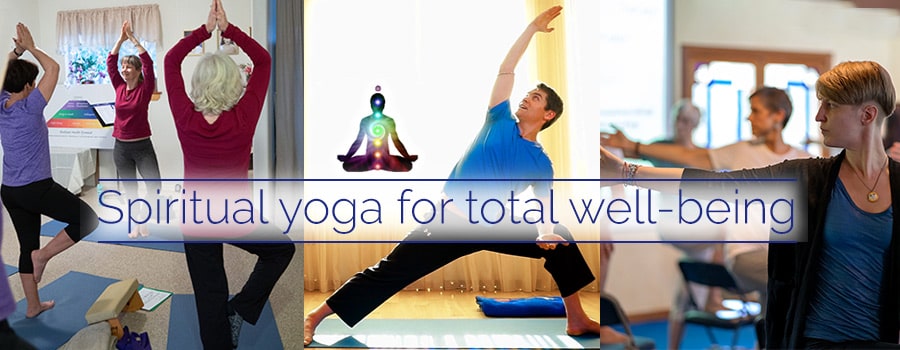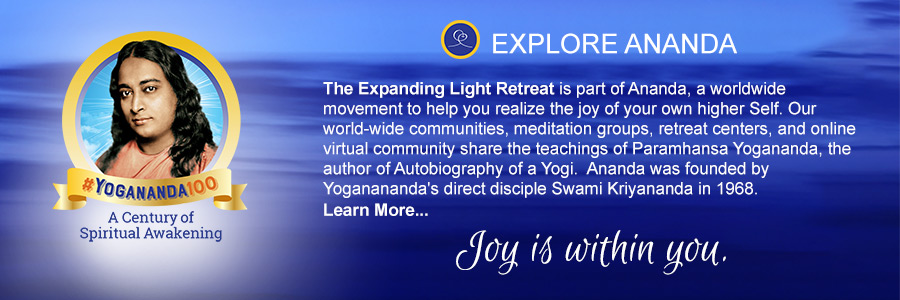Discovery via Challenges
Part 3 of “Teaching the Art of Discovery”
As we go deeper into this three-part series, I now want to offer some broader thoughts about how to refresh your approach to teaching, make your classes more magnetic and rewarding for your students, and increase your own satisfaction and magnetism.
In recent years, I’ve seen that some teachers let Ananda Yoga® slip into being a passive practice, making it so slow, gentle, and/or inward that students become distracted, sluggish, or bored. Sometimes they don’t come back, thinking that Ananda Yoga is too gentle and too slow.
I understand how that can happen. As we deepen our own inner experience and seek to share it, it’s easy to forget “beginner’s mind” and the fact that newcomers to Ananda Yoga — even those with prior asana experience — might not be ready for so inward a practice. The result can be “sleepy time yoga” rather than “awake and ready yoga.” For that matter, even experienced students who do understand the inward aspect can sometimes slip into passivity.
“Taking students inward without energy leads them downward into subconsciousness, not upward into superconsciousness.”
The truth is, real Ananda Yoga is never passive. Yes, it is slower and gentler than fast-paced, strenuous styles, and it is certainly an inward practice. But there’s no reason it should feel too slow, too gentle, or too inward. Ananda Yoga should (in my view) leave one feeling, not only relaxed and inwardly aware, but engaged, energized, and uplifted.
How can we give our students this experience? How can we make the depth of the practice more accessible? Here are two strategies that I invite you to explore:
- In every class, give your students definite challenges at the level(s) they’re ready for.
- Work more effectively with the pauses between poses.
The Case for Offering Challenges
First and foremost, I feel that many of us need to give our students more of a physical challenge, taking them to their frontiers of flexibility and yes, strength. This is not about caving in to the “workout yoga” fad. Rather, it’s about providing access to the core of Ananda Yoga practice: working consciously with energy.
For newer students, “energy” can be a mysterious and frustrating concept. In general, the easiest way to help them experience it is through physical effort.
Energization is ideal for this — “tense with will, relax and feel” — but challenging asanas offer a similar exertion/relaxation cycle: we exert energy to do the asana, and afterward in a neutral pose we can feel the energy move as we relax the muscles that were engaged. It’s a simple, down-to-earth energy experience.
I’m not suggesting that every pose should be a physical challenge. I’m saying only that putting out effort is a good way to get energy moving and feel it. Such poses also help students build strength and flexibility, and enjoy the “I can do it!” experience. They also give you opportunity to practice devising modifications for some of your students. All of this is very good, so long as it doesn’t supplant “inward and upward” as the goal of the practice.
Finding the Right Challenge
Of course, “harder poses” is just one type of challenge; we need to find the right challenge(s) for each class. There are many possibilities, including:
Endurance
Challenge your students to hold a pose longer without losing a core of relaxation. You could, for example, say, “When your body begins to strain or feel tired, concentrate on your breathing to help sustain both vigor and relaxation for a few more breaths.”
This skill is vital for asana practice: how will students connect with the inner essence of the asana if they exit the pose after only a short time? Besides, this is the beginning of learning a vital life skill: relaxation in the midst of effort.
Flexibility
For example, try holding the active phase of a forward bend for 60 — 90 seconds — with alignment! — to reach that day’s “final frontier” of hamstring/hip flexibility. Then enter the relaxation phase and notice the effect: the spine and entire body will feel much more open.
Then challenge your students to find a comparable spinal opening with a “normal” active phase — perhaps even just one breath. (By the way, there’s no benefit in taking more than 90 seconds: exercise physiologists say that after about 90 seconds of stretching, little or no more stretch will occur. More deepening of the inner experience can take place, but increased stretching won’t happen.)
Balance
You can do better than just seeing how long students can stay balanced. Rather, guide their exploration of various keys elements of balance: how uniformly distributing weight over the soles of the feet makes the pose more do-able; how maintaining a springy awareness in the standing leg improves balance; or how breathing smoothly and evenly aids balance. All of this fosters a greater sense of discovery and engagement than merely struggling to stay upright.
Concentration
Challenge students to observe and control the workings of the mind during a pose. How long can they stay concentrated on relaxing a particular part of the body, on the breath, on the spine, on the affirmation, or on their mental/emotional reactions to doing the pose?
Body Awareness
Challenge them to master simple-but-key bodily movements that take them deeper into a pose. For example, externally rotating the leading hip in Trikonasana or Virabhadrasana to create openness in the pelvis without compromising knee alignment. Or creating a dynamic “inside arc” in Chandrasana by lengthening up through the inside leg and inner side of the spine.
Relaxation
Even this can be a challenge if you guide students to work with body, breath, and mind in a neutral pose to find ever-deeper levels of physical and mental stillness and focus without going subconscious.
These and other challenges will engage, energize, and uplift your students as they explore and expand their limits.
Again, don’t challenge them so much that you lose the central point of the practice — bringing energy inward and upward — but do give all your students the opportunity to rise to the occasion. I will even go so far as to say that, without challenges of some kind, it’s hardly Ananda Yoga at all.
Does This Fit with Ananda Yoga?®
You may be wondering whether this suggestion is really consistent with Ananda Yoga. You may ask:
Question: “But what about safety?”
Answer: Safety is not incompatible with challenging poses. It simply requires more attention on the part of both teacher and student. That attention itself is a wonderful challenge for students — and for us as well, since we must observe students more closely. That often means that we cannot do the poses ourselves, but that’s fine since our teaching is not our personal practice — or at least, it shouldn’t be.
Question: “Isn’t Ananda Yoga about relaxation? How can they relax if we are challenging our students?”
Answer: You may, for example, recall Swami Kriyananda’s words, “All progress in yoga comes through relaxation of effort.” But “relaxation of effort” doesn’t mean that we should collapse in a heap because then we can relax more. Swami is calling for “dynamic relaxation”: engaging ever more energy, but always with a sense of relaxation. We want “relaxation in the midst of effort,” not “relaxation instead of effort.”
True, some poses are about total relaxation (Balasana, Savasana, etc.), but most involve effort. Finding relaxation in the midst of that effort frees up energy and builds concentration, taking students to a deeper, more satisfying practice. At the same time, they will be learning a valuable life skill.
The truth is, “relaxation instead of effort” is a dangerous habit, whether in asana, pranayama, meditation, or life itself. It causes the atrophy of one of the most valuable tools that we can help our students develop: willpower.
Remember Paramhansa Yogananda’s maxim, “The greater the will, the greater the flow of energy!” The more we exercise willpower by putting out energy — with relaxation — the stronger our willpower becomes. To build willpower, Yogananda prescribed, “each day, do something you haven’t done before,” and “each day, do something that you didn’t think you could do.” Sounds to me like he’s in favor of challenges!
Question: “Will students have an inner experience if they are constantly straining?”
Answer: “Strain” is to be avoided, but “exertion” is helpful (although even exertion shouldn’t be constant). I’m simply saying that we need a balance, and that some of us have gone too far in the direction of inwardness without energy.
Someone once asked Jack Nicklaus, the greatest golfer ever, how he would train a youngster to become a great golfer. His answer: “I would first teach him to hit the ball hard. Finesse and control can come later.”
Translation into the teaching of Ananda Yoga: if we first help students increase their energy and feel it (while staying safe), that will open the door to subtler aspects of the practice. Only with energy can students go inward and upward. Taking them inward without energy leads them downward into subconsciousness, not upward into superconsciousness.
The Pause That Truly Refreshes
Now let’s turn to the pauses between poses, because this is one area in which it’s especially easy for students to be left behind. Here are two common-sense suggestions for keeping them “on board.”
The Newer the Students, the Shorter the Pauses
Newer students can quickly lose focus during pauses because “nothing is happening” (as far as they can tell). Their minds wander and their energy scatters or dissipates — restlessness and boredom soon follow. We can prevent this simply by engaging them in another asana before they drift off — without shortening the pause so much that we create a vinyasa (“flow”) practice instead of Ananda Yoga.
How long should pauses be? In The Art and Science of Raja Yoga, Swami Kriyananda says to pause “at least as long as one has held the pose, and longer if the heart has been so activated that it takes more time to return to its normal rhythm.”
However, we also need to keep in mind that over the past couple of decades, Western (especially American) culture has become pathologically restless. People now are addicted to constant change and have pitifully short attention spans.
We’ll be better able to keep new students engaged if we use shorter pauses, say 5 — 6 breaths (20 — 25 seconds), or even 2 — 3 breaths (8 — 10 seconds) after poses that require minimal physical recovery (e.g., Garudasana, Janushirasana). In time, as they learn how to do work with energy, we will be able to lead them into longer, more-productive pauses.
In the end, the duration of a pause must be guided by your “feel” for the students rather than by any outward rule. Newer students will use the pause mainly for physical recovery; that doesn’t take long. Experienced students may benefit from a longer pause to internalize the effect of the preceding pose and re-center in the spine; even they will benefit from shorter pauses now and then, however, because it can keep them from “drifting” and help them feel more energy in their practice. In either case, try to begin the next pose before students can slip into restlessness, distraction, or passivity.
Give Students Appropriate Guidance During Pauses
Our instructions during pauses also need to be tailored to the students. Experienced students might respond well to instructions such as “integrate the effects of the pose” or “draw the energy into the spine.” New students, however, may find such instructions vague and/or frustrating because they don’t yet feel the effects or the energy; then instead of helping them center their energy in the spine, the pause will allow the energy to scatter or dissipate. They may do better if you have them focus on the bodily sensations instead.
For example, ask them to “consciously relax the muscles that were working in that pose.” Or call their attention to particular body parts, such as, “Notice the sensation of ‘release’ in your shoulders. Feel that sensation moving inward to your spine.” Students will soon begin to perceive the release of energy that underlies muscular relaxation. (By the way, this will happen sooner if you teach them Energization.)
Whatever your wording, the important thing is to accomplish the purpose of the neutral pose: help your students stay focused, integrate the effects of the preceding pose (to whatever degree they can), and prepare for the next pose.
Finding the Balance
I confess to feeling trepidation that some teachers will take these suggestions too far and begin teaching “workout yoga” instead of Ananda Yoga. Please keep in mind that these suggestions are intended only to push the pendulum back to center for those for whom it has swung too far in the direction of “slow, gentle, and inward.” You might already be doing what I’ve suggested here, but I believe that it will prove helpful to many Ananda Yoga teachers.
Also, I’m not saying that “slow, gentle, and inward” is wrong. It’s perfect for some classes — one can be slow, gentle, and inward without being passive. I merely want to point out that Ananda Yoga® also offers more-challenging possibilities on many levels. I encourage you to guide your students’ exploration of those possibilities so they can experience the dynamic, transforming essence of Ananda Yoga.
Related Articles
All authors are graduates of Ananda Yoga Teacher Training.





















